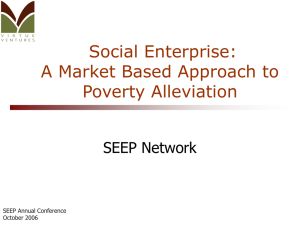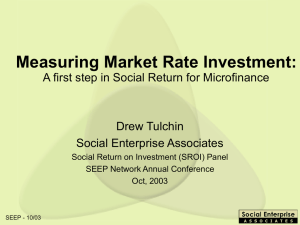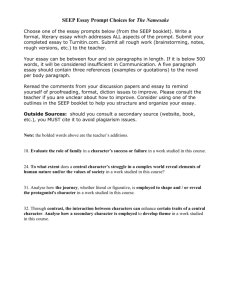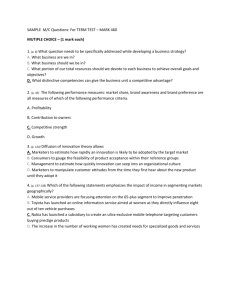Value Chain Analysis Program Design Process SEEP Network Annual General Meeting Pre-Event Workshop:
advertisement
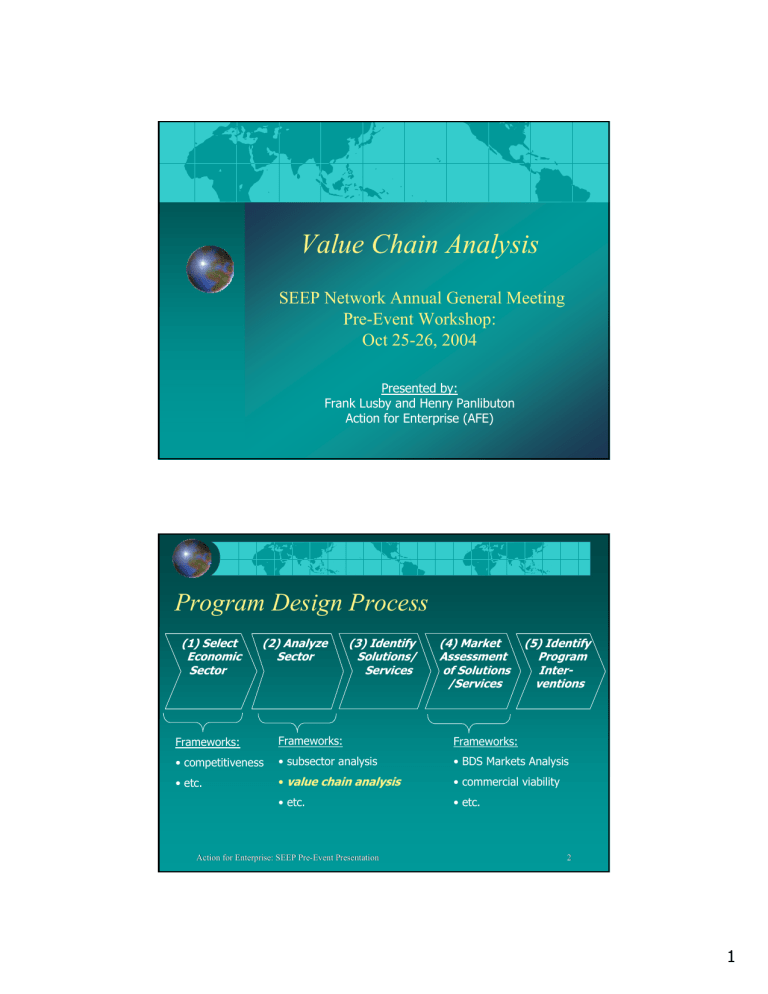
Value Chain Analysis SEEP Network Annual General Meeting Pre-Event Workshop: Oct 25-26, 2004 Presented by: Frank Lusby and Henry Panlibuton Action for Enterprise (AFE) Program Design Process (1) Select Economic Sector (2) Analyze Sector (3) Identify Solutions/ Services (4) Market Assessment of Solutions /Services (5) Identify Program Interventions Frameworks: Frameworks: Frameworks: • competitiveness • subsector analysis • BDS Markets Analysis • etc. • value chain analysis • commercial viability • etc. • etc. Action for Enterprise: SEEP PrePre-Event Presentation 2 1 Presentation Outline 1. What is Value Chain Analysis? 2. How to gather Value Chain information? 3. Why is Value Chain Analysis important? Action for Enterprise: SEEP PrePre-Event Presentation 3 Subsector and Value Chain Analysis value chain analysis is complementary to subsector analysis provides additional analytical elements that can improve the program design process builds on the foundation of a subsector analysis framework Action for Enterprise: SEEP PrePre-Event Presentation 4 2 Subsector and Value Chain Analysis Services/Solutions to upgrade MSEs Value Chain Analysis Subsector Analysis Action for Enterprise: SEEP PrePre-Event Presentation 5 What is a Subsector? Definition: – range of activities required to bring a product or service to the final consumer – includes producers, processors, input suppliers, exporters, retailers, etc. – includes both vertical and horizontal linkages – can be defined by a particular finished product or service • e.g. wood furniture, green beans for export, etc. ** the same definition can be applied to Value Chains Action for Enterprise: SEEP PrePre-Event Presentation 6 3 Elements of Subsector Analysis 1) Understanding Product Markets and Market Trends 2) Relationships between Participants – describes functions, participants, and relationships among participants 3) Identification of Constraints and Opportunities – including: technology, market access, organization, policy, finance, input supply, etc. Action for Enterprise: SEEP PrePre-Event Presentation 7 4) Subsector mapping – graphic presentation of inter-relationships; – can help to identify participants to interview Action for Enterprise: SEEP PrePre-Event Presentation 8 4 Baskets (for Export) Subsector Map International Export Market Regional Export Market Export Trading Production Regional Traders Export Agents Export Companies Broker Subcontractors Production Subcontractors Individual Producers Elements of Value Chain Analysis 1) Geographic Coverage – value chain analysis reviews activities at all levels (national, regional, global) 2) Global Benchmarking – benchmarking (with competing countries) – learning from buyers – use of star diagrams Action for Enterprise: SEEP PrePre-Event Presentation 10 5 FOOTWEAR Performance Comparison: India – Italy Quality 5 4 Innov Design 3 Price 2 India Italy 1 0 Flex Large Orders Resp Time Flex Small Orders Punctuality Source: Learning From Global Buyers; H. Schmitz, P. Knorringa (IDS) 3) Inter-firm Cooperation – level of cooperation among participants in value chain – degree of interaction (beyond buying and selling) – structure of transactions (e.g. subcontracting, etc.) 4) Governance – who decides what is produced? – how are the rules of trade determined? – what is the nature of relationships between participants? Action for Enterprise: SEEP PrePre-Event Presentation 12 6 Types of Value Chain Governance Market-based – “arm’s length” transactions between buyers & sellers – little or no formal cooperation among participants Balanced – fairly equal decision making among participants – cooperation but no one dominates Directed – controlled by firm(s) who determine product specifications, trade rules, etc. Action for Enterprise: SEEP PrePre-Event Presentation 13 Hierarchy – vertically integrated enterprise that controls various functions along value chain ** Type of governance may vary within different parts of a single value chain Action for Enterprise: SEEP PrePre-Event Presentation 14 7 Value Chain Governance Structures Market Balanced Directed Hierarchy (Tomatoes) (Organic Coffee) (Export Crafts) (Cut Flowers) Buyers Buyers Major Buyer Integrated Firm Price Suppliers Suppliers Suppliers Source: The Governance of Global Value Chain; Gereffi, Humphrey, Sturgeon Small Group Exercise Break-out into five groups of 5-6 people each Read the value chain case Discuss and answer the following questions: – what type of governance structure does it have? – what are the advantages or disadvantages to this governance structure? Action for Enterprise: SEEP PrePre-Event Presentation 16 8 Subsector and Value Chain Analysis Governance Inter-firm Cooperation Market Trends Services/Solutions to upgrade MSEs Global Benchmarking Geographic Coverage Constraints & Opportunities Relations Among Participants Subsector Mapping Program Design Process (1) Select Economic Sector (2) Analyze Sector (3) Identify Solutions/ Services (4) Market Assessment of Solutions /Services (5) Identify Program Interventions Frameworks: Frameworks: Frameworks: • competitiveness • subsector analysis • BDS Markets Analysis • etc. • value chain analysis • commercial viability • etc. • etc. Action for Enterprise: SEEP PrePre-Event Presentation 18 9 Presentation Outline 1. What is Value Chain Analysis? 2. How to gather Value Chain information? 3. Why is Value Chain Analysis important? Action for Enterprise: SEEP PrePre-Event Presentation 19 Information Gathering & Compilation 1) Review Available Data 2) Develop Initial Map 3) Gather Primary Data Action for Enterprise: SEEP PrePre-Event Presentation 20 10 Review Available Data Where can you get data on subsectors/value chains? studies and reports – government, donors, development projects, etc. web-based research etc. Action for Enterprise: SEEP PrePre-Event Presentation 21 Develop Initial Map Mapping Steps – – – – identify final markets identify key functions/activities identify participants performing each function map participants according to functions they perform – map inter-relationships between participants Action for Enterprise: SEEP PrePre-Event Presentation 22 11 Milk Subsector/Value Chain Map Rural Consumer Urban Consumer Poor (10,000) Retailing Hawker/Milkbar Wholesaling (145,000) (90,000) Caterer/Hotel (10) Small Retailer Traders (5,000) Large/ Medium Dairies Processing Rich Large Retailer Small Dairies (20) (10) Pastuerizing Cooling Farmer Groups Collection/ Bulking Smallholder Farmers Production Medium/Large Dairy Farmers (2,000) (625,000) Channel 1 Channel 2 Channel 3: Pasteurized Raw Milk Channel 4: Milk Prod. Gather Primary Data guided interviews with key informants and value chain participants focus group discussions stakeholder meetings ** specific details of these tools will be presented at the Tools Workshop (Day 2) Action for Enterprise: SEEP PrePre-Event Presentation 24 12 Presentation Outline 1. What is Value Chain Analysis? 2. How to conduct value chain analysis? 3. Why is value chain analysis important? Action for Enterprise: SEEP PrePre-Event Presentation 25 Value Chain Analysis can help to… Reveal links between producers, exporters and global markets Identify constraints all along the chain to competing in the marketplace Clarify the relationships in the chain from buyers to producers Highlight the distribution of benefits among buyers, exporters and producers in the chain Action for Enterprise: SEEP PrePre-Event Presentation 26 13 Link to MSE development understanding of value chains increasingly important for MSE development USAID/AMAP Hypothesis – greater integration of MSEs into value chains can contribute to: • improved enterprise performance, • household well-being, and • growth and competitiveness of value chain Action for Enterprise: SEEP PrePre-Event Presentation 27 Program Design Process (1) Select Economic Sector (2) Analyze Sector (3) Identify Solutions/ Services (4) Market Assessment of Solutions /Services (5) Identify Program Interventions Frameworks: Frameworks: Frameworks: • competitiveness • subsector analysis • BDS Markets Analysis • etc. • value chain analysis • commercial viability • etc. • etc. Action for Enterprise: SEEP PrePre-Event Presentation 28 14 Value Chain References and Links The Manual for Value Chain Research on Home Workers in the Garment Industry – D. McCormick, H. Schmitz; Nov 2001 – www.ids.ac.uk/ids/global/pdfs/wiegomanualendnov01.pd Promotion of Commercially Viable Solutions to Subsector and Business Constraints – F. Lusby, H. Panlibuton; Apr 2004 – www.actionforenterprise.org/paper0404.pdf Learning From Global Buyers – H. Schmitz, P. Knorringa – www.ids.ac.uk/ids/bookshop/wp/wp100.pdf Action for Enterprise: SEEP PrePre-Event Presentation 29 15
